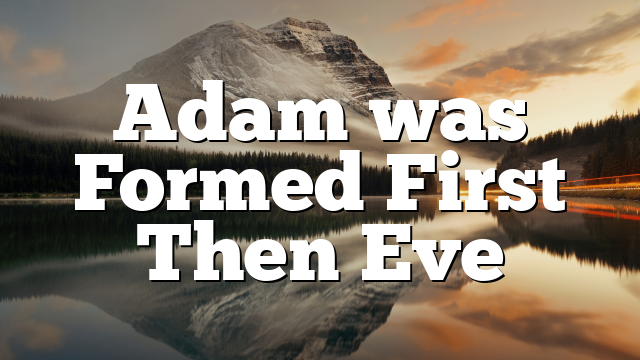Click to join the conversation with over 500,000 Pentecostal believers and scholars
Click to get our FREE MOBILE APP and stay connected
| PentecostalTheology.com



This week we begin the process of untangling our cultural assumptions about women from the biblical design for women. To learn more from Dr. Schaser and to discuss more Biblical examples, enroll in his course HERE.
Read more about Carol Meyer’s view of Israelite Patriarchy HERE.
Find out how you can get this and many other courses with one small monthly subscription at: https://israelbiblecenter.com
Stay connected with IBC on Facebook @IsraelBibleCenter or Twitter @IsraelStudy



Anonymous
Adam was created from mud and Eve was formed from the waist bone of Adam by God. Amen! Amen!
Anonymous
Rasiah Thomas Wrist Bone? “Then the rib which the LORD God had taken from man He made into a woman, and He brought her to the man.” Ge 2:22
Anonymous
Jeffrey Snyder some rabbis say it was not a bone but his bone*
Anonymous
Jeffrey Snyder “And the rib, which the LORD God had taken from man, made he a woman, and brought her unto the man.” Although you are correct brother according to the English Bible, my language Tamil has been written “Waist Bone” in all South Indian languages only. Thanks for correcting me. May God Bless you!
Anonymous
Rasiah Thomas ☺
Anonymous
Rasiah Thomas The Rabbis have different opinions about the source from which Eve was created. Gen. 2:21 states that “He took one of his ribs.” One exegetical opinion understands zela (rib) as “side,” as in (Ex. 26:20) “and for the other side wall [zela] of the Tabernacle”; hence, God created Eve from Adam’s sides. In another midrashic understanding, God took a rib from between two others and closed the flesh under the remaining ribs (Gen. Rabbah 17:6). According to these opinions, God removed something from Adam when He created Eve. Comparing Eve’s creation with the construction of the Tabernacle imparts sanctity to her, and the Rabbis frequently draw analogies between the creation of a family and the erection of the hallowed Tabernacle.
A similar notion is that Adam was created two-faced, as it is said (Ps. 139:5): “You hedge [or, formed] me before and behind” (this creature had a face in front and another behind, one of a male, and the other of a female). In creating Eve, God cut this creature into two, forming a back for Adam and a back for Eve (Gen. Rabbah 8:1; a similar motif appears in the early Babylonian literature and in Plato’s Symposium; see the references by L. Ginzberg, Legends of the Jews, vol. 5, pp. 88–89, n. 42).
Another midrash is occupied with the physical appearance of the woman’s body, which differs from that of the man. Gen. 2:22 states: “And the Lord fashioned the rib,” from which the Rabbis learned that God fashioned Eve as a storehouse [for fruits]. Just as a storehouse is narrow at the top and broad at the bottom to hold the fruits, so, too, the woman is narrow above and broad below so that she can bear the fetus (BT Berakhot 61a). Eve’s body structure is here presented as functional, for purposes of pregnancy. This dictum explains the different physical structure of man and woman as part of God’s wisdom in Creation, in which each body serves the need of its gender.
The Rabbis understood the word va-yiven in “And the Lord fashioned [va-yiven] the rib” to mean that God plaited Eve’s hair in a braid around her head, bedecked her as a bride, and thus brought her to Adam; in some places the plaiting of hair is called “binyan.”
https://www.haaretz.com/jewish/2015-12-29/ty-article/god-didnt-use-adams-penis-bone-to-make-eve/0000017f-f90b-d460-afff-fb6f8e4f0000
Anonymous
here is my comment with the words and the rabbis Link Hudson
So you didnt find BAR convincing without reading it
Haaretz gave the opposite view – you didnt read it
and I can suppose you missed my quote from the rabbis too
AND out of this partial knowledge you drew your global conclusion
I already posted the BAR once The Hebrew word that is traditionally translated as “rib” is tsela‘. Ziony Zevit, Distinguished Professor of Biblical Literature and Northwest Semitic Languages at American Jewish University in Bel-Air, California, believes that this translation is wrong, as do many scholars. It was first translated as “rib” in the Septuagint, a Greek translation of the Hebrew Bible from the mid-third century B.C.E. However, a more careful reading of the Hebrew word for “rib” in the Adam and Eve story suggests that Eve was created from another, very different, part of Adam’s anatomy—his os baculum (penis bone).
The Rabbis have different opinions about the source from which Eve was created. Gen. 2:21 states that “He took one of his ribs.” One exegetical opinion understands zela (rib) as “side,” as in (Ex. 26:20) “and for the other side wall [zela] of the Tabernacle”; hence, God created Eve from Adam’s sides. In another midrashic understanding, God took a rib from between two others and closed the flesh under the remaining ribs (Gen. Rabbah 17:6). According to these opinions, God removed something from Adam when He created Eve. Comparing Eve’s creation with the construction of the Tabernacle imparts sanctity to her, and the Rabbis frequently draw analogies between the creation of a family and the erection of the hallowed Tabernacle.
A similar notion is that Adam was created two-faced, as it is said (Ps. 139:5): “You hedge [or, formed] me before and behind” (this creature had a face in front and another behind, one of a male, and the other of a female). In creating Eve, God cut this creature into two, forming a back for Adam and a back for Eve (Gen. Rabbah 8:1; a similar motif appears in the early Babylonian literature and in Plato’s Symposium; see the references by L. Ginzberg, Legends of the Jews, vol. 5, pp. 88–89, n. 42).
Another midrash is occupied with the physical appearance of the woman’s body, which differs from that of the man. Gen. 2:22 states: “And the Lord fashioned the rib,” from which the Rabbis learned that God fashioned Eve as a storehouse [for fruits]. Just as a storehouse is narrow at the top and broad at the bottom to hold the fruits, so, too, the woman is narrow above and broad below so that she can bear the fetus (BT Berakhot 61a). Eve’s body structure is here presented as functional, for purposes of pregnancy. This dictum explains the different physical structure of man and woman as part of God’s wisdom in Creation, in which each body serves the need of its gender.
The Rabbis understood the word va-yiven in “And the Lord fashioned [va-yiven] the rib” to mean that God plaited Eve’s hair in a braid around her head, bedecked her as a bride, and thus brought her to Adam; in some places the plaiting of hair is called “binyan.”
Zevit carefully examines the account of the creation of woman in the Bible in his article “Was Eve Made from Adam’s Rib—or His Baculum?” which appears in the September/October 2015 issue of Biblical Archaeology Review.
Anonymous
Link Hudson did you read this one/?
The Hebrew word that is traditionally translated as “rib” is tsela‘. Ziony Zevit, Distinguished Professor of Biblical Literature and Northwest Semitic Languages at American Jewish University in Bel-Air, California, believes that this translation is wrong, as do many scholars. It was first translated as “rib” in the Septuagint, a Greek translation of the Hebrew Bible from the mid-third century B.C.E. However, a more careful reading of the Hebrew word for “rib” in the Adam and Eve story suggests that Eve was created from another, very different, part of Adam’s anatomy—his os baculum (penis bone).
Zevit carefully examines the account of the creation of woman in the Bible in his article “Was Eve Made from Adam’s Rib—or His Baculum?” which appears in the September/October 2015 issue of Biblical Archaeology Review.
Anonymous
Troy Day It doesn’t go into the details. I read the article on the page and a link that also did not go into the details of the argument. The verses you listed weren’t very convincing. Are there any cases where the ord actually means that in Hebrew?
Anonymous
Link Hudson not sure about ANY of that – I was interested in the plenty details the rabbis interpreted. The Hebrew words were also abundant. I am not certain about any external sources but the use of a BIBLE word in a certain way is certainly my thing and this spoke volumes. What else could be discussed about a spare bone? I dont have a dog on that bone